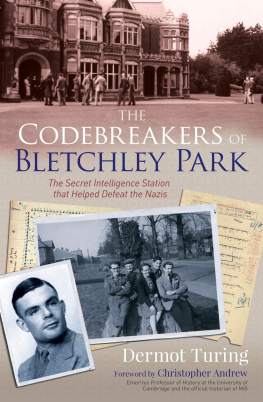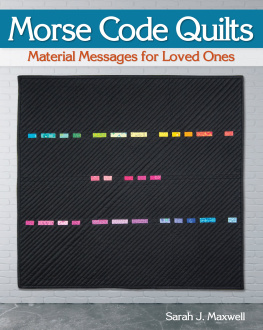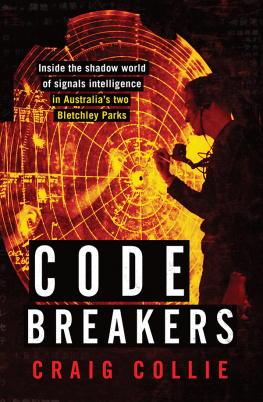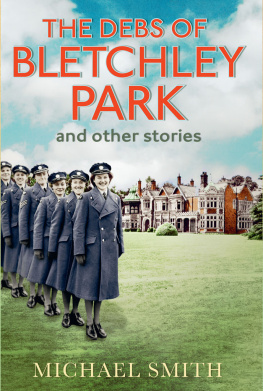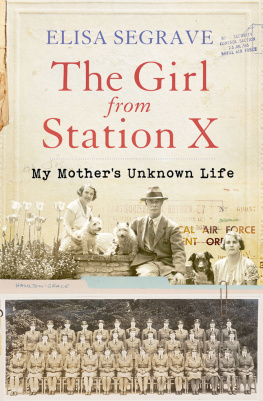Morse Code Wrens of Station X
Bletchleys Outer Circle
Anne Glyn-Jones
Petty Officer Telegraphist,
WRNS, 19421945

amphorapress.com
2017 digital version converted and published by
Andrews UK Limited
www.andrewsuk.com
Copyright Anne Glyn-Jones, 2017
The moral rights of the author have been asserted.
No part of this publication may be reproduced in any form without permission, except for the quotation of brief passages in criticism and discussion.
Amphora Press is the trade books division
of Imprint Academic Ltd.
Imprint Academic Ltd., PO Box 200, Exeter EX5 5YX, UK
Cover image courtesy of the Imperial War Museum,
used with permission.
Foreword by HRH The Princess Royal, Admiral Chief Commandant for Women in the Royal Navy

In 2017 we celebrate the 100th anniversary of the founding of the Womens Royal Naval Service (WRNS). During the First World War the Royal Navy became the first of the three services to recruit women. Nicknamed Wrens the women were initially recruited to release men to serve at sea, but as the Navy expanded so did the Wrens responsibilities to include driving, operating radar equipment, planning naval operations, and code breaking work.
Intercepting German Morse Code signals was one of the jobs Wrens were tasked with when recruited to Station X, or Bletchley Park, and its outstations known as Y Stations. We now know just how important this undercover work was, and the Wrens played a vital part making up around 75% of the workforce.
The WRNS was integrated into the Royal Navy in 1993 but still has approximately 45,000 former members ranging in age from their thirties to their nineties. As patron of the WRNS Benevolent Trust I am delighted that Anne Glyn-Jones, now aged 94, has been able to leave us this valuable contribution to the WRNS history. Her bravery, tenacity and discretion are a shining example to younger women today wanting to make a contribution to society by serving those around them.

Prologue
Since the commitment to secrecy, to which we were all bound, began to be relaxed in the late 1970s, much has been said and written about the contribution to the war effort of the code-breakers of Bletchley Park. Much less has been made known about the lives and work of those without whom Bletchley Park would have had no texts on which to work, the men and women of all three Services and even beyond who became what Sinclair Mackay called, in his pioneering work of 2012, The Secret Listeners , or, as it was called (from WI, Wireless Intelligence), the Y-Branch. Some were linguists, listening to spoken enemy radio transmissions; others were telegraphists, trained in Morse communications. This memoir seeks to expand their story so far as one group was concerned - the WRNS contingent of telegraphists.
There were listening stations all over the world, facilitated by the widespread reach of the British Empire. Security ensured that those who worked at them had no idea either of the existence of Bletchley Park or of our relationship to it. I once overheard a charge-hand (they were civilian operators, who had gone into pre-war Y work on retirement from the Royal Navy) say, in relation to a problem at work, Maybe BP could help us with that one, and I presumed they were not referring to Buckingham Palace, but I did not ask, and would have been reprimanded if I had. Need to know was always the criterion, and I did not need to know. Marion Hills Bletchley Park People, published in 2004, pinpoints the mindset we were required to develop. At Bletchley a 1942 security warning emphasized the importance of discretion even within Bletchley itself. Do not talk at meals. Do not talk in the transport. Do not talk travelling. Do not talk in the billet. Do not talk by your own fireside. Be careful even in your hut.
We heard only of Station X, where we presumed someone was trying, though with what degree of success we did not know, to decode the messages we so diligently transcribed. Despatch riders took away the messages we wrote down, but no one knew to what destination they rode. Transmission was later bolstered by teleprinters, and Wren teleprinter operators appeared on the scene. How messages reached Station X from overseas listening posts we had no idea.
The first crack in the security wall appeared in 1974, with the publication of F.W. Winterbothams The Ultra Secret , and only then, more than thirty years after I got involved, did I first learn of the existence of Bletchley Park. During the 1970s, records containing Enigma/Ultra material began to be released to the Public Record Office, and this led to enquiries as to whether we were still subject to our vows of secrecy - vows which were life-long, not governed by the so-called thirty years rule. David Owen MP, then Foreign Secretary, made clear in a written answer to a question in the House of Commons in January 1978 that while it was permissible for those involved to say what they had been doing during the war, any reference to the content of their work must not go beyond what had been released to the PRO, and any information as to how the information had been obtained remained classified.
In 1979 came the first volume of F.H. Hinsleys magisterial official history, British Intelligence in the Second World War, Vol. II of which, published in 1981, covered the story of Bletchleys involvement in the U-boat battles in which the Wren telegraphists were so deeply engaged. Following these revelations, a leading British military historian, commissioned by Oxford University Press to write a definitive history of the Y-Branch, contacted some of us for help, and we asked the then Foreign Secretary, Geoffrey Howe, where we stood. Though by now a trickle of books was beginning to appear, and presumably receiving clearance, we were referred back to David Owens restrictive guidance of 1978. The historian sadly died in 1984, so that ended the possibility of seeing our story told.
Throughout the 1980s the Bletchley site remained neglected, the huts sinking into dereliction and the site attracting development interest for housing. In May 1991 the Bletchley Archaeological and Historical Society formed a committee to trace Bletchley veterans for a Farewell Party designed to put final closure to Bletchleys wartime story. Over 100 people came, and their reminiscences led to the determination to save the site as a memorial to the work that had been done there. In February 1992 the Bletchley Park Trust was formed, and by arrangement with the landlords, the site was opened to visitors in 1994. Anxious negotiations and fund-raising over the next five years led to the site being permanently secured in June 1999. Central to the Trusts ambitions was the reconstruction of Colossus, described as the worlds first programmable computer, brilliantly devised in the early 1940s by Tommy Flowers, a post office engineer, but completely destroyed at the end of the war together with all other evidence of Bletchleys activities. Tony Sale, an electronics engineer, not only successfully achieved this reconstruction (completed in 2007), but also served as the Trusts Secretary and was appointed the Trusts security liaison officer.
By then, in 1993, the first formal reunion of Y-Branch operators had assembled at Bletchley, some half-century after the activity that had formed their joint experience. Of course, small groups of friends had always kept in social touch, and there was an active Tels(S) Association, largely composed of operators formerly working in the Far East, but the Bletchley Reunion was a formally organized occasion covering all activities pursued at Bletchley, with lectures and much exchange of information. The following year, in the autumn of 1994, the Second Reunion attracted some 250 veterans, who enjoyed a weekend of talks that widened many restricted horizons. The Trust, through Tony Sale, was now actively seeking reminiscences from veterans, and authority to talk was sought from GCHQ, who in December 1994 gave qualified approval, notifying us that the dispensation from the obligation of confidentiality (under the Official Secrets Act) about your work relates only to this undertaking and to discussions about it with Mr Sale, who was himself bound to use documentary material only as authorized by GCHQs security officer. Since we, on the listening stations, knew absolutely nothing about Colossus, this dispensation did little to liberate us.
Next page


